Customer Journey Analysis, a strategic technical process that let businesses understand the way customers interact with brands. From the very first encounter to the post-purchase engagement, every touchpoint paints a vivid picture of preferences, hesitations, and motivations.
Let's say Sarah, an e-commerce online shopper, stumbles upon a boutique fashion brand through a engaging Instagram ad. As interested, she explores the brand's website, researching into product descriptions, reviews, and the seamless checkout process. This marks the beginning of her journey, a journey that will extend far beyond a simple transaction.
Through Customer Journey Analysis, businesses can follow Sarah's footsteps, having a comprehensive understanding of what captures her interest, what builds trust, and what fosters a sense of loyalty.
This insights are beneficial, as it helps brands to make data-driven decisions that improve customer experiences and drive conversions.
Here are the topics that we will cover in this blog:
- What is Customer Journey Analysis?
- Why Do Companies Use Customer Journey Analytics?
- Customer Journey Mapping vs. Customer Journey Analytics
- Top 5 Customer Journey Analysis Tools
- Steps to Perform Customer Journey Analysis
- 9 Metrics for Analyzing the Customer Journey
What is Customer Journey Analysis?
Customer Journey Analysis is a strategic process in marketing, it's all about understanding the steps a customer takes when they connect with a brand or business. We're talking about every interaction - from when they first hear about a product to when they become customer to do post-purchase engagement.
This analysis dives deep into what makes customers tick - their likes, dislikes, and what makes them hesitate.
This way, businesses can make better marketing decisions and efforts by comprehensively tracking and analyzing these touchpoints, such as website visits, social media interactions, and customer support interactions that improve customer experiences and drive conversions.
Customer Journey Analysis plays a pivotal role in crafting personalized marketing campaigns, refining product offerings, and improving overall customer satisfaction.
It aligns business's efforts with the customer's needs and expectations, fostering long-lasting and profitable relationships.
5 Customer Journey Stages
The customer journey comprises a series of stages that individuals progress through when interacting with a brand, from initial awareness to post-purchase engagement.
This comprehensive exploration of the customer journey stages provides invaluable insights for businesses aiming to optimize their strategies and enhance customer experiences.
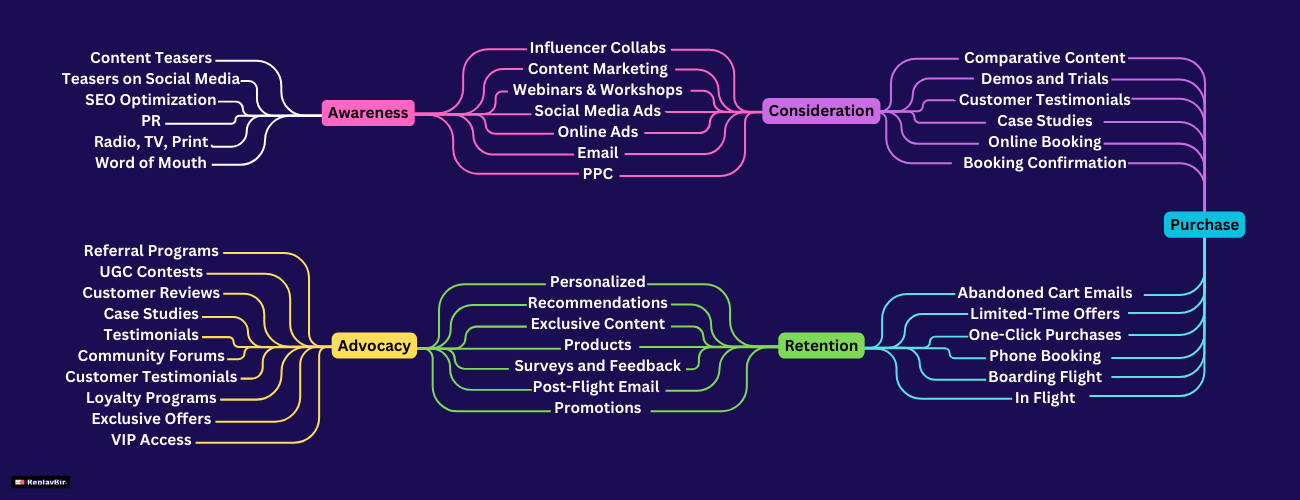
1. Awareness Stage
Every customer journey typically begins at the awareness stage as a potential customer first finds a brand, product, or service.
It awareness stage could be through various channels such as social media, search engines, advertisements, or word of mouth as the key here is to grab attention and interest.
For instance, a person might get interested upon a captivating social media post showcasing the latest gadget, prompting them to explore further.
During this stage, businesses uses compelling content, eye-catching visuals, and persuasive messaging to leave a positive first impression. It's not just about making a sale; it's about building a connection and establishing credibility.
2. Consideration Stage
After the initial introduction, potential customers move to the consideration stage as they may start to measure the brand or product against their needs, preferences, and alternatives.
This is the time for in-depth research and comparison shopping where the customer wants to know more:
- How does this product differ from similar ones?
- What are the benefits?
- Are there reviews or testimonials to validate its quality?
Businesses must provide detailed, informative content at this stage which includes product specifications, expert reviews, and customer testimonials.
3. Decision Stage
As customers progress through their journey, they reach the decisive stage as they're confident to make a choice. They've weighed the options, considered the benefits, and are now ready to commit.
It's preconditioned for businesses to make this transition as appealing as possible.
This is where persuasive techniques, such as limited-time offers, personalized recommendations, and transparent pricing, come into play to build trust and confidence in the brand as it can be the deciding factor that leads to a conversion.
4. Post-Purchase Stage
A customer journey never ends with a purchase as it evolves to the post-purchase stage for a cultivating customer loyalty and advocacy.
This is the time to ensure that the customer is delighted with their decision. It's an opportunity to exceed expectations and solidify the brand-customer relationship.
Businesses have to engage with their customers through various means, such as post-purchase emails, surveys, and special offers for future purchases.
Exceptional customer service and prompt issue resolution can help to shape the overall perception of the brand.
5. Advocacy Stage
Ideally, a satisfied customer becomes an advocate. In this stage, customers who have had a positive experience become vocal proponents of the brand. They share their experiences, recommend products, and even defend the brand in conversations.
Creating an environment that encourages advocacy involves maintaining a high standard of quality, personalized communication, and actively seeking feedback. Social proof, in the form of customer testimonials or user-generated content, is a powerful tool for influencing potential customers.
6. Retention and Loyalty Stage
Retaining customers is more important just as acquiring new ones whereas this retention stage in customer journey focuses on nurturing long-term relationships.
Loyal customers not only make repeat purchases but also tend to spend more and become less price-sensitive.
Businesses invest in loyalty programs, exclusive offers, and personalized communication to keep customers engaged and appreciated as consistent, high-quality experiences, along with exceptional customer service, are the cornerstones of customer retention.
Why Do Companies Use Customer Journey Analytics?
Companies are now in a terrible competetive field where they need to pave the way for smoother and more satisfying experiences.
Customer journey analytics helps companies in channel optimization, ensuring resources are allocated judiciously to identifies pain points, which may lead to customer dissatisfaction or abandonment.
#1 Understanding Customer Behavior
Customer journey analytics is the major tool used by companies to get a comprehensive understanding of their customers' behavior as they can track and analyze every touchpoint a customer has with their brand, from the initial awareness stage to the final purchase and beyond.
By studying this journey, companies can identify patterns, preferences, and pain points whixh let them to make informed decisions about marketing strategies, product offerings, and customer service improvements.
#2 Improved Customer Experience
The absolute reason behind companies investigating customer journey analytics is to improve the overall customer experience.
By mapping out the customer's interactions, businesses can pinpoint areas where improvements are needed.
For instance, they can find major bottlenecks in the purchasing process or areas where customers commonly abandon their carts which let them to streamline their processes, making it easier and more enjoyable for customers to engage with their brand website.
#3 Personalization and Targeted Marketing
Personalization has become a key aspect of our modern online marketing. Customer journey analytics provides the data necessary to create highly personalized experiences.
By understanding each customer's preferences, browsing behavior, and past interactions, companies can customize their marketing messages and product recommendations.
This approach not only increases the likelihood of conversion but also fosters a stronger sense of loyalty and connection with the brand.
#4 Optimizing Marketing Channels
As companies are now operating across various marketing channels, including social media, email, website, and physical stores, understanding which channels is most effective for different stages of the customer journey is one of the best decisions companies need to look over.
Customer journey analytics helps in attributing conversions to specific channels to allocate their resources more effectively.
For instance, if a majority of conversions are coming from social media ads, a company might choose to allocate more budget to this channel.
#5 Identify Pain Points and Friction
Every customer journey has its pain points or moments of friction that can lead to dissatisfaction or abandonment. Customer journey analytics helps in identifying these pain points.
It could be a slow-loading webpage, a confusing checkout process, or inadequate customer support.
Once identified, companies can take proactive steps to address these issues, ultimately leading to a smoother and more satisfying customer experience.
#6 Measuring and Improving Customer Satisfaction
Customer satisfaction is a key metric for any business as customer journey analytics provides a quantitative way to measure satisfaction at various touchpoints along the journey.
By tracking metrics like Net Promoter Score (NPS) or Customer Satisfaction Score (CSAT), companies can gauge how well they are meeting customer expectations. This data serves as a valuable feedback loop to make continuous improvements and ensure a high level of customer satisfaction.
Customer Journey Mapping vs. Customer Journey Analytics
Customer Journey Mapping is a qualitative, visual representation of the customer experience, while Customer Journey Analytics is a quantitative, data-driven analysis of customer interactions and behavior.
Both are valuable tools, and when used together, they provide a comprehensive understanding of the customer journey.
Customer Journey Mapping:
Customer Journey Mapping is a visual representation of the entire customer experience, from the first interaction to the last. It is a qualitative tool that focuses on understanding the customer's emotions, motivations, and pain points at each touchpoint.
This process involves creating a visual flowchart or diagram that outlines the various stages a customer goes through when interacting with a brand.
Customer Journey Mapping helps teams acquire empathy for the customer's experience and provides a holistic view of the customer's perspective.
Key Characteristics of Customer Journey Mapping:
- Qualitative Focus: It emphasizes understanding the customer's feelings, thoughts, and motivations throughout their journey.
- Visual Representation: It often involves creating diagrams or flowcharts that visually illustrate the customer's interactions and emotions.
- Emphasis on Empathy: It aims to put the team in the customer's shoes, helping them see the experience from the customer's perspective.
- Identifying Pain Points: It helps in pinpointing specific areas where customers may face challenges or frustrations.
- Creating Personas: It often involves the development of customer personas to better understand different segments and their unique journeys.
Customer Journey Analytics:
Customer Journey Analytics is a data-driven approach that involves the collection, analysis, and interpretation of quantitative data related to customer interactions.
It focuses on metrics, such as conversion rates, click-through rates, and customer behavior, to gain insights into the effectiveness of each touchpoint.
Customer Journey Analytics uses tools and technologies to track and measure customer interactions across various channels.
Key Characteristics of Customer Journey Analytics:
- Quantitative Focus: It relies on numerical data and metrics to analyze customer behavior and interactions.
- Data-Driven Insights: It leverages technologies like analytics platforms to collect and process large volumes of customer data.
- Conversion Tracking: It measures key performance indicators (KPIs) like conversion rates, bounce rates, and customer acquisition costs.
- Attribution Modeling: It helps in attributing conversions or actions to specific touchpoints or channels.
- Optimization and Testing: It enables businesses to experiment with different strategies and measure their impact on the customer journey.
Top 5 Customer Journey Analysis Tools
- ReplayBird: ReplayBird is a comprehensive customer experience optimization platform. It offers a range of features including session replay, heatmaps, conversion funnels, and behavioral analytics. ReplayBird helps businesses understand and improve the digital customer experience by providing deep insights into user behavior and interactions.
- Hotjar: Hotjar offers a suite of tools including heatmaps, session recordings, surveys, and more. It helps you visualize how users interact with your website, enabling you to identify pain points and areas for improvement.
- Mixpanel: Mixpanel specializes in user analytics for web and mobile applications. It provides event tracking, funnels, retention analysis, and user segmentation to understand how users engage with your product.
- Crazy Egg: Crazy Egg provides heatmaps, scrollmaps, referral maps, and user recordings to help businesses understand how visitors interact with their websites. It's particularly useful for identifying areas of interest and drop-off points.
- Kissmetrics: Kissmetrics offers behavioral analytics to track and analyze customer interactions. It provides insights into customer journeys, retention, and segmentation to optimize marketing efforts.
Steps to Perform Customer Journey Analysis using ReplayBird
Step 1: Start a New Map
Click on "path analysis", you will be taken to the default map of all the paths under one graph.
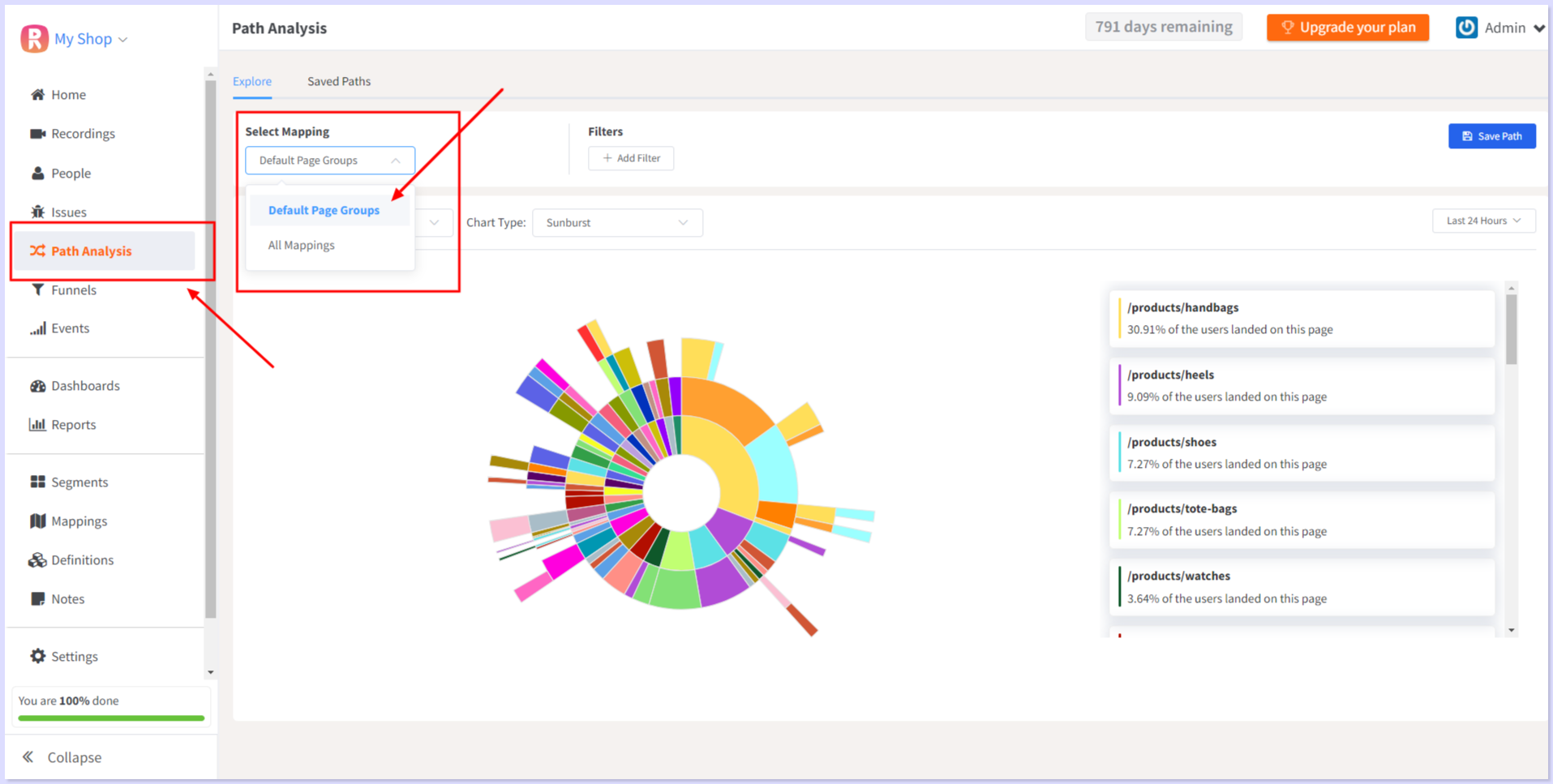
Step 2: Apply filter
Filters can be based on various criteria such as demographics, behavior, or specific time frames to narrow down the data on specific segments or journeys.
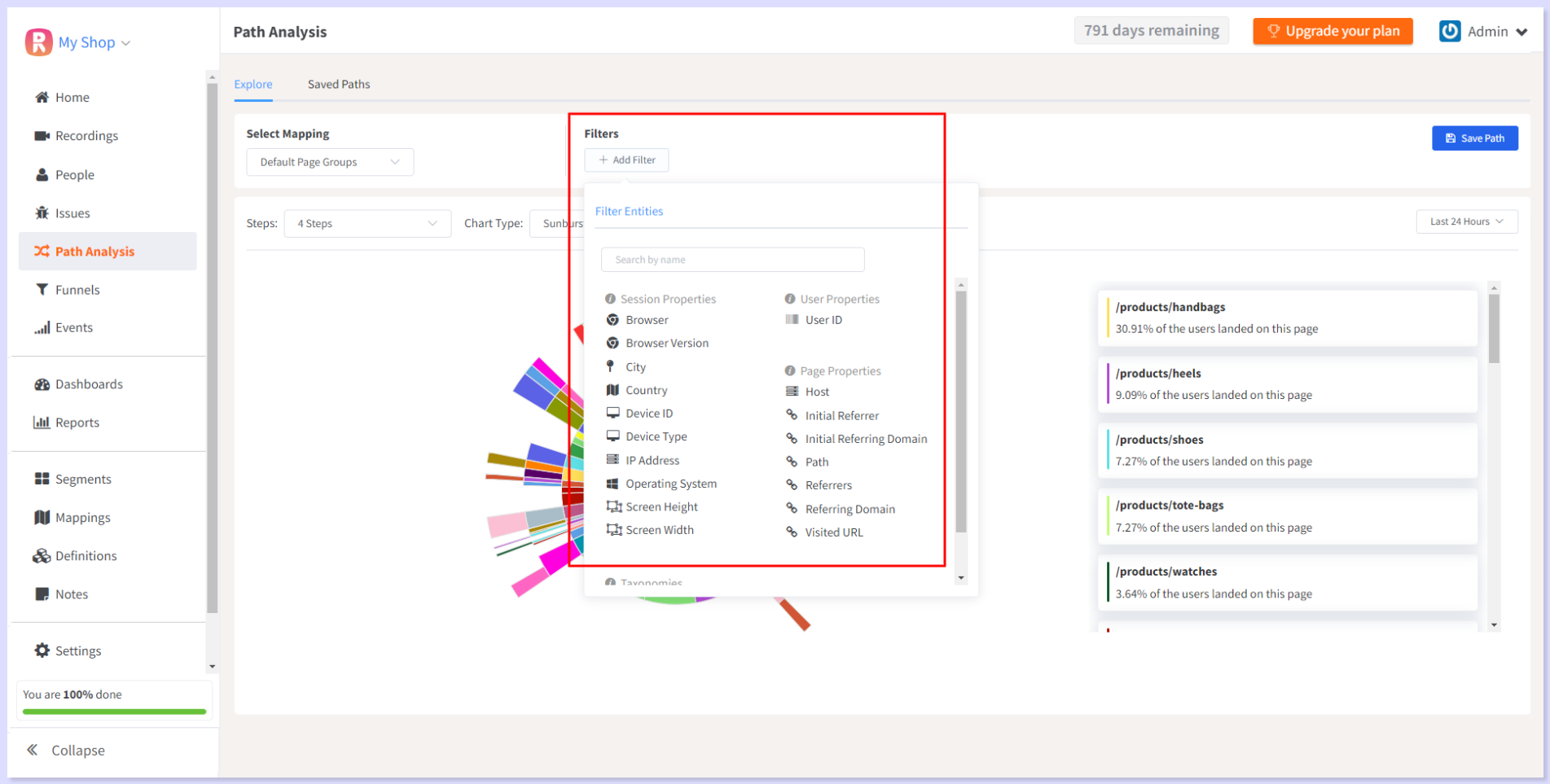
Step 3: Determine number of Steps
You can add how many of steps you want to visualze your customer's journeyt from one single page to various other pages. For instance, a simple journey might involve just a few touchpoints, while a more complex one could span multiple stages.

Step 4: Select Chart type: Sankey or Sunburst
Choose the chart type for visualizing the customer journey.
- Sunburst chart: A radial view for representing hierarchical data.
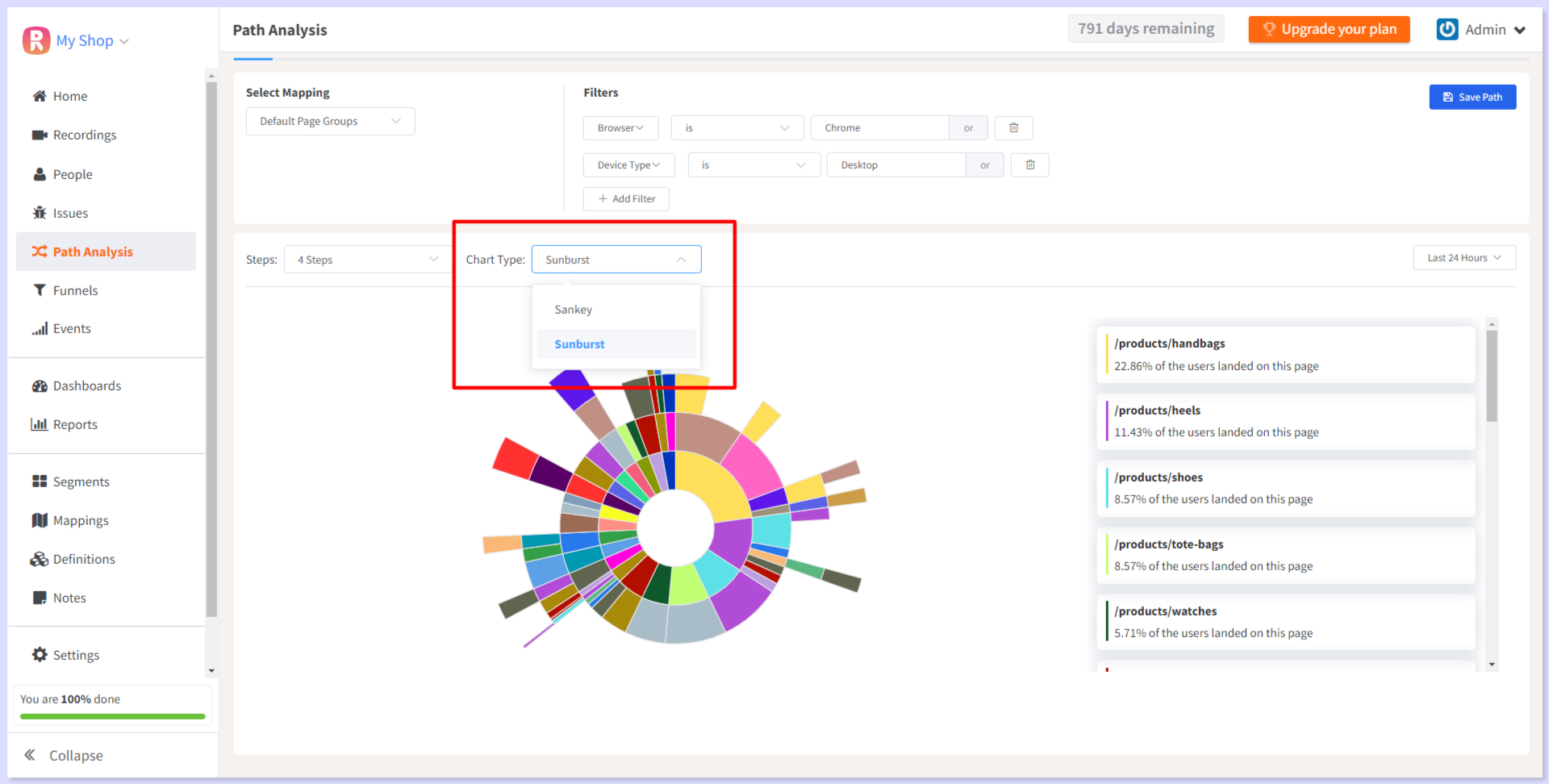
- Sankey diagram: Display the flow of interactions between stages.
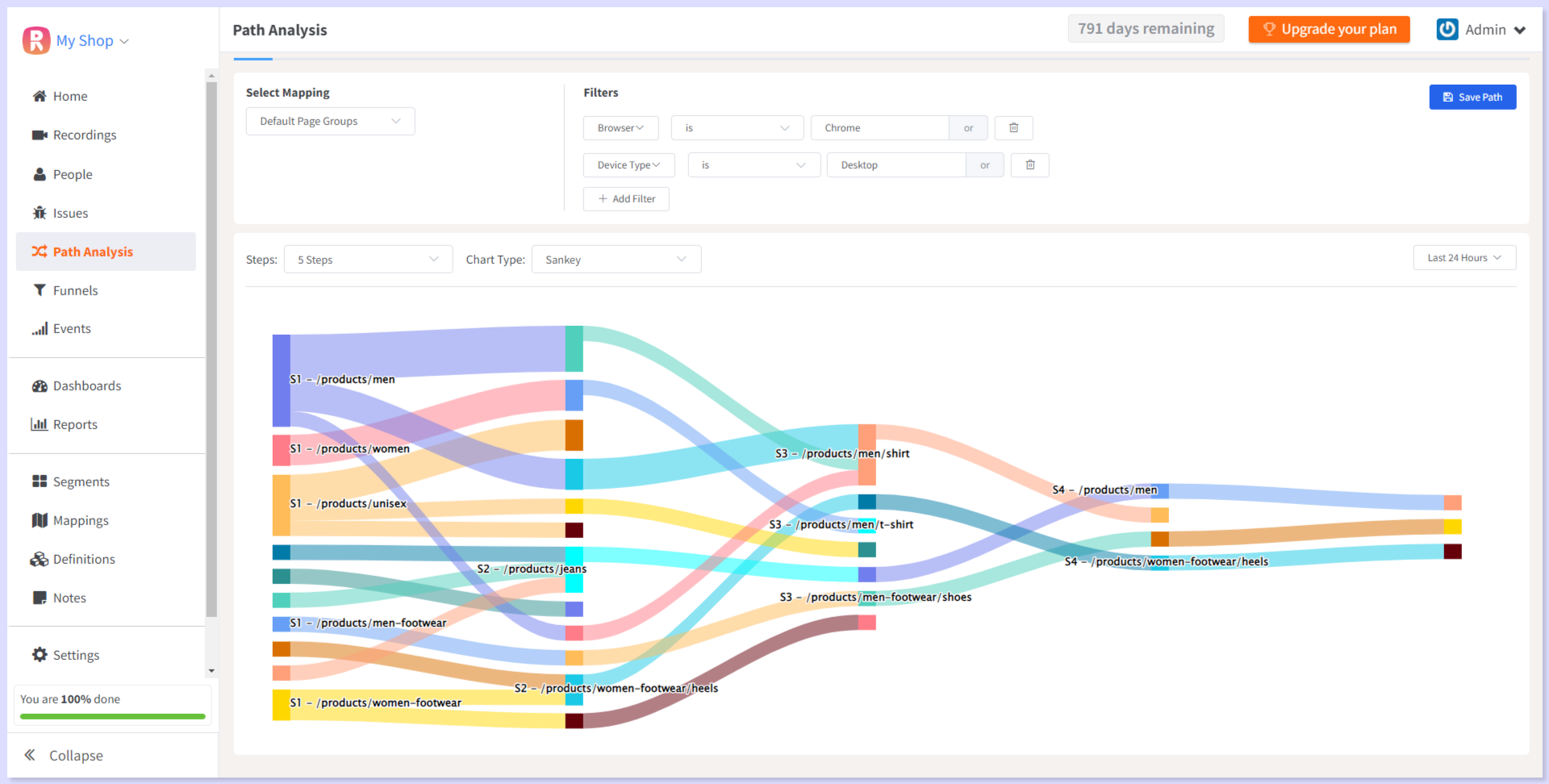
Step 5: Save path
Save the customer journey path once you have configured the filters, selected the number of steps, and chosen the chart type. You can revisit and analyze the same customer journey in the future or share it with other team members for collaboration.
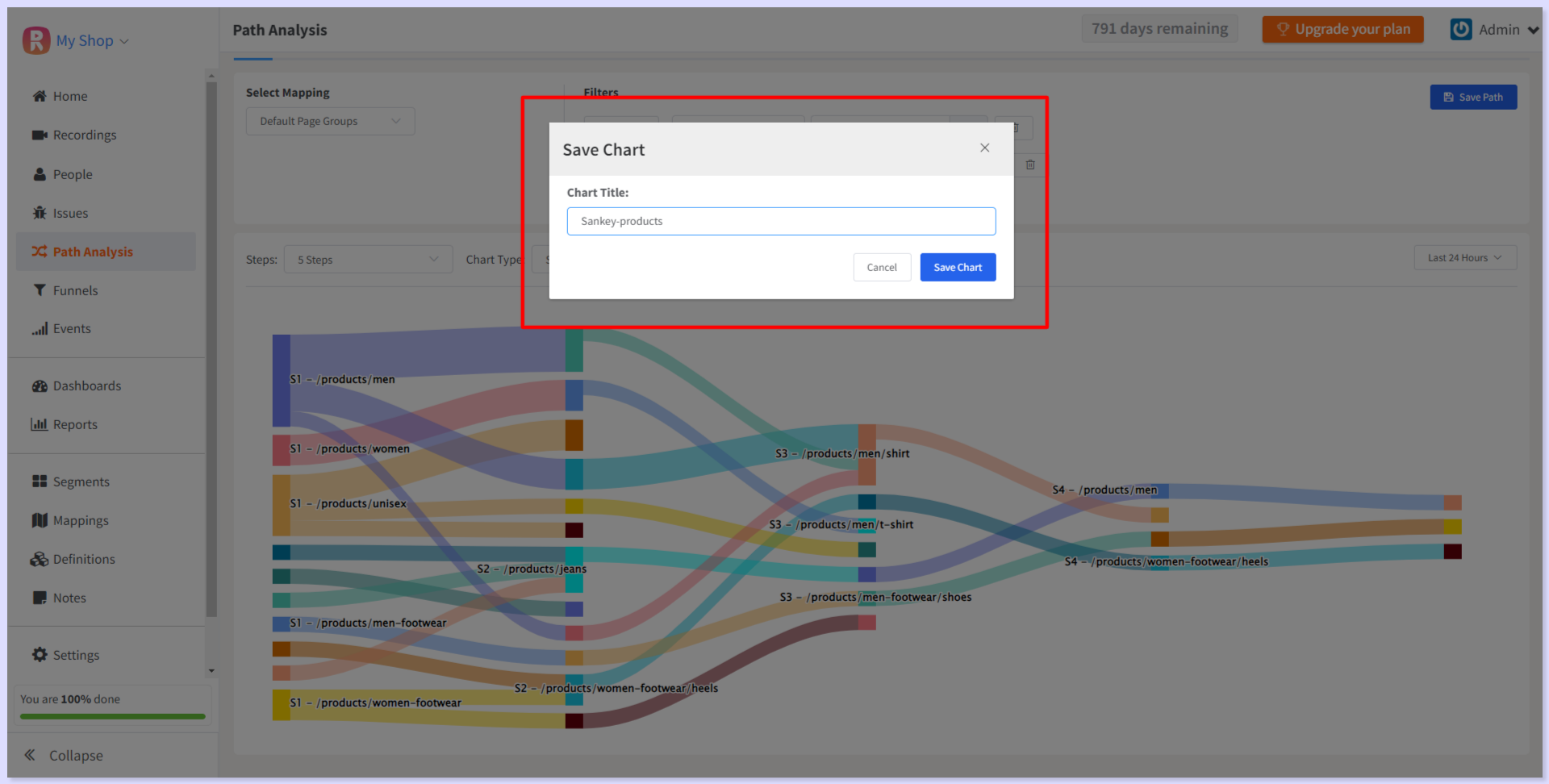
9 Metrics for Analyzing the Customer Journey
#1 Conversion Rate
The Conversion Rate measures how many visitors or leads take a specific action, like making a purchase or signing up. It shows how effective each step is in moving customers forward.
For example, if a customer goes from learning about a product to considering it and then buying it, the conversion rate at each step shows how well you guide them.
A lower rate may mean there's something slowing them down, which needs fixing. By checking rates at different points, you can make improvements like clearer messaging, better user experience, or providing incentives for a smoother process.
Calculate your conversion rate here for free

#2 Cart Abandonment Rate
The Cart Abandonment Rate is crucial for online stores. It shows the percentage of visitors who add items to their cart but don't finish the purchase.
In the customer journey, it helps find where customers might face problems. For example, if many abandon carts during checkout, it could be due to payment, shipping, or trust issues.
By fixing these, businesses can make the buying process smoother and improve the overall customer experience.
#3 Customer Churn Rate
The Customer Churn Rate shows how many customers stop using or buying from your brand for a period of time. It helps find where and why customers lose interest.
For example, if many customers leave after a certain point, it might mean there's a problem there. It could be because of a bad experience, unmet expectations, or not enough value. Knowing this, businesses can make things better.
They can improve products, offer better support, or add more value to keep customers interested.
#4 Customer Lifetime Value (CLV)
The Customer Lifetime Value (CLV) is how much revenue you can expect from a customer throughout their relationship with your brand. Understanding CLV helps you spend resources wisely. It shows which parts of the customer journey can bring in more revenue.
For example, if a certain step consistently brings in more value from customers, it's smart to focus on improving that part to get more from each customer.
Calculate your customer lifetime value here for free
#5 Net Promoter Score (NPS)
The Net Promoter Score (NPS) measures how satisfied and loyal customers are to your brand. It gives a quick view of their overall experience with your brand.
You can ask for NPS feedback at different points in the customer journey. For example, after a purchase, ask if they'd recommend your brand.
If a specific point gets consistently low NPS ratings, it's a sign that it needs improvement. Fixing these areas can make the overall customer journey better, leading to more satisfaction and loyalty.
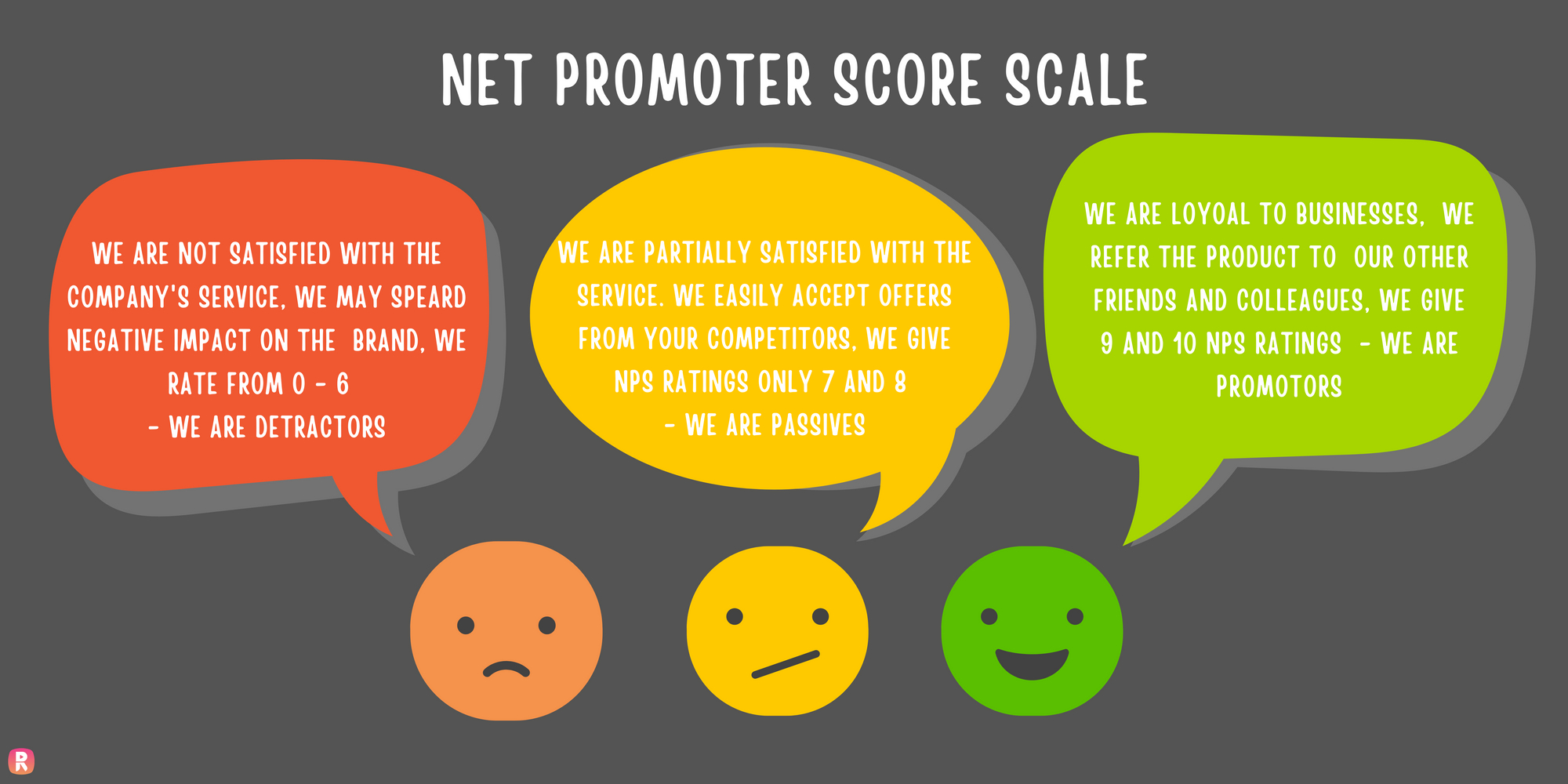
#6 Click-Through Rate (CTR)
The Click-Through Rate (CTR) is important for checking how well your marketing messages engage your audience.
In the customer journey, CTR helps you see if your content is interesting and relevant at different points.
For example, a high CTR for an email campaign means it's popular during the consideration phase. But if a product page has a low CTR, the content may need improvement.
Calcluate your Click-through Rate CTR here for free
#7 Bounce Rate
The Bounce Rate serves as a critical metric, measuring the proportion of visitors who exit a website after viewing just one page.
A detailed analysis of bounce rates throughout the customer journey yields invaluable insights into the efficacy of each touchpoint in sustaining visitor interest.
For instance, if a landing page exhibits a substantial bounce rate, it suggests that the content or call-to-action may not align with visitor expectations.
#8 Customer Retention Rate
The Customer Retention Rate measures how many customers stick with your brand and keep coming back over time. This helps you see how well your strategies are keeping customers engaged.
To make the most of this metric, track retention at different stages of the customer journey. This helps you figure out which points have the biggest impact on customer loyalty.
For example, if customers stick around after a follow-up, it shows they value the support they get. This lets you focus your efforts on the most effective touchpoints for keeping customers.
#9 Return on Investment (ROI)
Return on Investment (ROI) is a crucial metric that tells you how profitable your marketing efforts are. In customer journey analysis, it shows which touchpoints are most effective in generating revenue and growing your business.
To use ROI effectively, assess it at different stages of the customer journey. This helps you allocate resources wisely. For example, if a campaign performs well in the consideration phase, it's smart to invest more in similar efforts. ROI data helps you refine strategies so each touchpoint brings a positive return.
Calculate your Return on Investment (ROI) here for free
Conclusion:
Customer Journey Analysis align business' efforts with customer needs, driving meaningful interactions, and ultimately, business success.
It's not just about making a sale, but about building lasting connections and delivering exceptional value at every step of the customer's journey.
The customer journey is a multi-stage process, starting from awareness and progressing through consideration, decision, post-purchase, advocacy, and retention.
By using the Customer Journey analytics, businesses can thrive in today's competitive market by putting their customers at the center of their strategies.
Understand Exactly How Your Users Interact with Your app
ReplayBird, a digital user experience analytics platform designed specifically for developers with advanced insights to optimize your applications like a pro!
Unleash the power of behavioral insights with ReplayBird's intuitive heatmaps, session replays, and clickstream analysis allows you to visualize user behavior, identify popular elements, and detect pain points that might hinder user satisfaction.
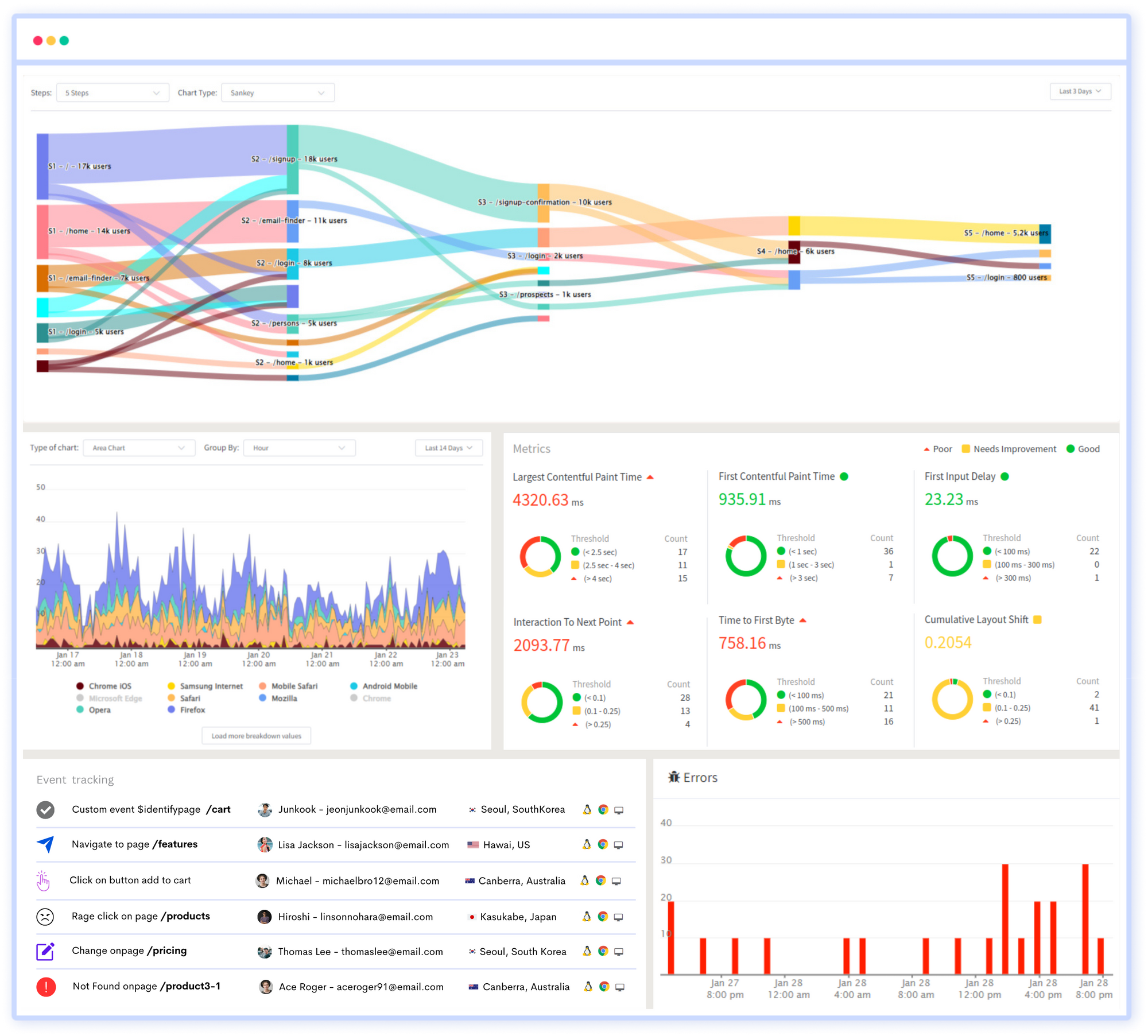
Customer journey analysis and conversion funnels of ReplayBird to analyze deeper into user journeys, identify where drop-offs occur, and uncover conversion blockers.
Troubleshooting is now simpler with ReplayBird's robust debugging features. Detect and diagnose UX issues quickly, ensuring a seamless user journey from start to finish.
With ReplayBird, you have the ultimate toolkit to elevate your projects to the next level. The platform empowers you to create high-performing, user-centric applications that leave a lasting impression.


